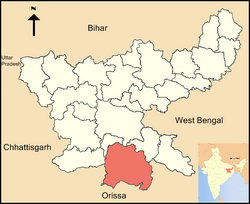West Singhbhum district
|
West Singhbhum district पश्चिमी सिंहभूम जिला |
|
|---|---|
| District of Jharkhand | |
 Location of West Singhbhum district in Jharkhand |
|
| Country | India |
| State | Jharkhand |
| Administrative division | Kolhan division |
| Headquarters | Chaibasa |
| Government | |
| • Lok Sabha constituencies | Singhbhum (shared with Seraikela Kharsawan district) |
| • Assembly seats | 5 |
| Area | |
| • Total | 5,351 km2 (2,066 sq mi) |
| Population (2011) | |
| • Total | 1,501,619 |
| • Density | 280/km2 (730/sq mi) |
| Demographics | |
| • Literacy | 59.54 per cent |
| • Sex ratio | 1001 |
| Average annual precipitation | 1422 mm |
| Website | Official website |
West Singhbhum or Pashchimi Singhbhum is one of the 24 districts of Jharkhand state, India. It came into being in 1990, when the old Singhbhum district was bifurcated. Chaibasa is the district headquarters.
The district is bounded on north by Khunti district, on the east by Saraikela Kharsawan district, on the south by Keonjhar, Mayurbhanj and Sundergarh districts of Odisha and on the west by Simdega district of Jharkhand and Sundergarh district of Odisha.
West Singhbhum is one of the oldest districts of Jharkhand. After the British conquest of Kolhan in 1837, a new district was consequently constituted to be known as Singhbhum with Chaibasa as its headquarters. Subsequently three districts, namely East Singhbhum, West Singhbhum and Saraikela-Kharsawan have been carved out of erstwhile Singhbhum district.
West Singhbhum district came into existence when the old Singhbhum District bifurcated in 1990. With 9 community development blocks the Eastern part became East Singhbhum district with Jamshedpur as its headquarters and with remaining 23 blocks the larger Western part became West Singhbhum district with Chaibasa as its headquarters. In 2001 West Singhbhum again divided into two parts. With 8 blocks Saraikela-Kharsawan district came into existence. At present West Singhbhum remains with 15 blocks and two administrative sub-divisions.
There are several accounts relating to the origin of the name of the district:
It is currently a part of the Red Corridor.
West Singhbhum district forms the Southern part of the newly created Jharkhand state and is the largest district in the state. The district spreads from 21.97°N to 23.60°N and from 85.00°E to 86.90°E. The district is situated at an average height of 244 metres above sea level and covers an area of 5351.41 km².
The district is covered with hills alternating with valleys, steep mountains, and deep forests on the mountain slopes. It contains some of the best Sal tree forests and the famous Saranda forest. There are plenty of waterfalls and a large variety of wild life like elephants, bison, tigers, leopards, bear, wild dogs and wild boars. Sambar Deer and spotted deer are also found but their numbers are decreasing in the forests adjoining inhabited areas.
...
Wikipedia
